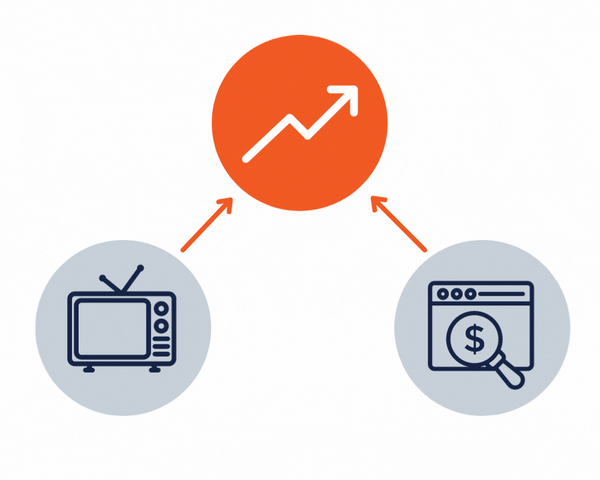What are the benefits of Nested Modeling?
 By
Tina Keightley
·
2 minute read
By
Tina Keightley
·
2 minute read
For those of you who aren’t familiar with nested models, they are a system of models used to represent an interactive relationship between independent drivers and multiple connected KPIs. For example, TV advertising and Paid Search might both lead to an increase in sales, but TV advertising might also boost the performance of Search. With nested thinking, we recognize that TV has a direct effect on sales as well as an indirect effect (by driving up Search). Nested modeling lets you account for this interaction but still get separate planning ROIs and response curves for each tactic.
.png)
 Additionally, by understanding the relationship between the various metrics for a brand we can gain a greater understanding of the steps on the customer journey, and how marketing activities work together. This also helps us avoid over-attributing the impact of those activities that are “easier” to measure when looking at Sales and under-estimating the impact of those activities that have most of their impact higher up in the funnel.
Additionally, by understanding the relationship between the various metrics for a brand we can gain a greater understanding of the steps on the customer journey, and how marketing activities work together. This also helps us avoid over-attributing the impact of those activities that are “easier” to measure when looking at Sales and under-estimating the impact of those activities that have most of their impact higher up in the funnel.
You can get a more detailed understanding of the benefits of nested models from our blog post "How Brand Health metrics can improve your Marketing Mix Modeling"
Marketing mix models, and nested models, by their very nature are backward-looking; however, you can really utilize their power by using the insights gained to forecast what will happen going forwards, evaluate what-if scenarios and to optimize your budget allocation.
Conducting these forward-looking analyses with nested models, where you are able to take account of both the direct and indirect effects of your marketing spend, really boosts the depth of understanding and your ability to plan effectively.
With strataQED we have simplified the process so that you can use a complex set of models within one practical planning tool. Additionally, with our latest Nested Forecasting module, you can create your system of nested models, forecast the likely impact of your marketing plan and optimize your budget allocation with just a few clicks of your mouse. It’s quick and easy to visualize and quantify the impact of changes to your marketing plan on each of the KPIs within your set of models.
A perfect example of this is when you’re trying to look at how, for example, media will drive Organic Search clicks in addition to the overall impact on your sales, based on the historical trends from your model. Using strataQED’s Nested Forecasting module, you can import a nested model (which will be composed of all the individual models), then you can input anticipated future Costs, Spends and Executions of paid media tactics, such as TV or Social Media, in the Forecast Display section. Then you can go to the Main Forecast tab and cycle through the individual models that make up the total nested structure to visualize how media will impact the total number of Organic Search Clicks, as well as the total Sales expected from your current media plan. You can also find other tabs that are familiar, such as the Contributions or ROI tab, where the breakdown of Direct, Indirect, and Combined effects can be quantified.
If you need to know if your sales target is attainable, or what is the optimal budget level, strataQED can give you the answer. On top of that, if your KPIs can be translated into monetary terms by inputting prices and margins, you can also optimize against revenue or profit, in addition to whatever metrics you modeled.
Clients have reported that the nested modeling module saves them approx. 2 days per project by automating the reattribution of marketing impacts. With the ability to use nested models to forecast and optimize, this time saving will only increase.
Want to know more?
If you are interested to learn more about how strataQED's Nested Optimization and Forecasting release can help you effectively plan your campaign, you can request a demo by clicking the button below.
-2.png?width=200&height=200&name=Untitled%20design%20(40)-2.png)
-2.png?width=50&height=50&name=Untitled%20design%20(40)-2.png)








